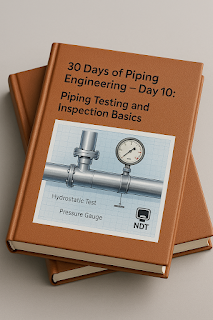30 Days of Piping Engineering – Day 10: Piping Testing and Inspection Basics
Welcome to Day 10 of our 30 Days of Piping Engineering series on our App! We’ve journeyed through fabrication, insulation, stress analysis, and more. Today, we’re wrapping up the first 10 days with piping testing and inspection basics—a crucial step to ensure your system is ready for operation.
What Are Piping Testing and Inspection?
Testing and inspection verify that a piping system meets design specifications, codes (like ASME B31.3), and safety standards before it goes live. These processes catch issues early, preventing failures. Here’s an overview:
- Types of Tests:
- Hydrostatic Test: The system is filled with water and pressurized beyond its operating pressure (e.g., 1.5 times the design pressure) to check for leaks or weaknesses.
- Pneumatic Test: Uses air or gas, often for systems where water isn’t suitable, but it’s riskier due to potential energy release.
- Leak Test: A low-pressure test with soap solution or gas detectors to identify small leaks after assembly.
- Inspection Methods:
- Visual Inspection: Checks for surface defects like cracks or improper welds, often the first step in quality control.
- Non-Destructive Testing (NDT): Techniques like ultrasonic testing or radiography ensure weld integrity without damaging the pipe.
- Dimensional Inspection: Verifies pipe lengths, alignments, and fittings match the design.
- Documentation: Results are recorded to comply with codes, often in detailed reports for regulatory approval.
These steps ensure the system can handle its intended service, whether it’s a refinery pipeline or a building’s water supply.
Real-World Example
In a natural gas plant, a hydrostatic test revealed a weak weld in a high-pressure line. The issue was fixed before startup, avoiding a potential explosion and saving millions in damages.
Did you know ?
The first documented pressure test for pipes was conducted in the late 1800s on gas mains in London? Engineers used water pressure to test cast iron pipes, setting the stage for modern testing standards like those in ASME codes!
Your Day 10 Takeaway
Piping testing and inspection are the final checks to ensure safety and reliability. Mastering these basics completes your foundation for the next phase of our series.
Tomorrow, we’ll start Day 11 with piping supports and hangers—see you then!
